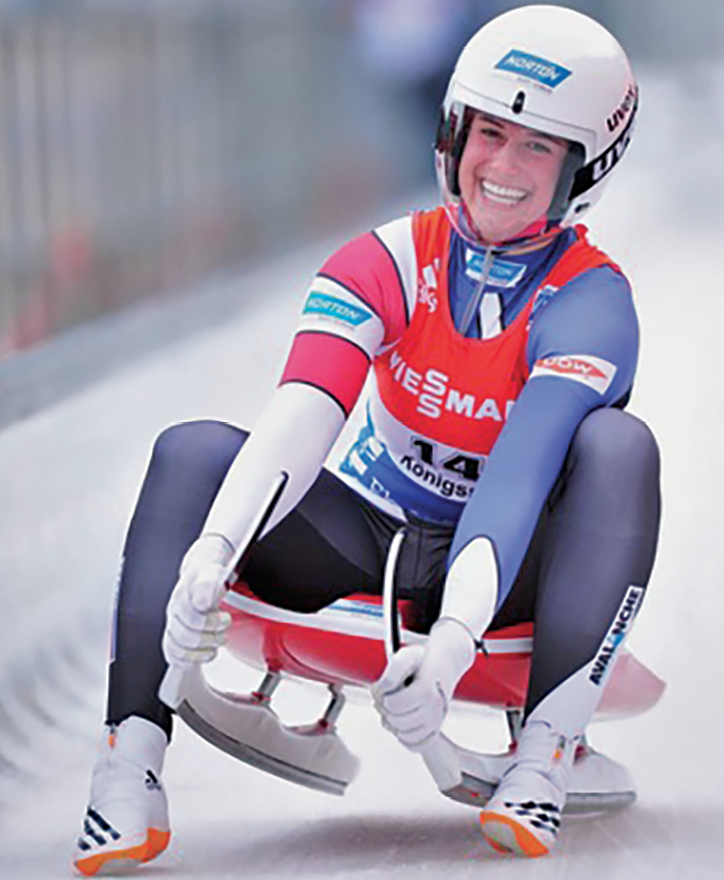
Photo provided by Suzan and Larry Sweeney
Emily Sweeney grins happily as she finishes one of her runs during the 2015 World Cup competion in Koenigssee, Germany.
Emily Sweeney is nothing if not resilient. After eight years on the World Cup circuit and two unsuccessful attempts to make the US Olympic luge team, the 24-year-old, who lists Suffield as her hometown, is about to realize her Olympic dream. As a Suffield High School junior, Emily missed qualifying for an Olympic berth on the 2010 luge team by less than two tenths of a second. Her only consolation was that it was her sister, and idol, Megan, who edged her out, so there would still be a Sweeney competing in Vancouver. Still young and promising, she had after all, as a sophomore, won Norton Junior World Champion honors as well as bronze medals at the Junior World Cup in Germany and a gold medal in Park City, Utah. Emily continued to train in the sport she loved.
After graduating from SHS and turning 18, Emily was inspired by her grandfather, a Navy veteran, to join the Army National Guard. She performed her basic combat training and advanced individual training at Fort Leonard Wood in Missouri where she graduated with honors from the military police school and impressed her superiors with her leadership abilities. More importantly for Emily’s dream, she joined the Army’s World Class Athlete Program (WCAP), which allowed her to continue training at the Lake Placid Olympic Training Center.
Going into the 2013 World Cup season, Emily was a favorite to qualify for the 2014 Olympics in Sochi, but it was not to be. Minor injuries, sled issues, and slow finish times on the World Cup circuit knocked her out of the competition. Heartbroken and in despair, she walked away from the sport that had been her life since the age of 10 when she joined the USA Luge Program after participating in a “slider search” in Rhode Island. She went from being an Olympic hopeful to totally withdrawing from sport.
In May 2014 however, Emily received orders to attend a Warrior Leader Course (WLC) at Fort Dix, N.J. Because she had not been regularly exercising for six months, she had lost weight and muscle mass, and for the first time since enlisting she did not receive the top score on the Army physical fitness test. That served as a wakeup call, and returning to a military regimen for the month long WLC spurred Emily to find a way back to her sled.
In December 2015 Emily and her teammates, at their home track in Lake Placid, swept the competition, which included beating the Germans, who lead all countries in luge medals. Although in a 2016 fall she injured her wrist and required minor surgery, Emily performed well enough in nine World Cup races in 2017 to rank 8th in the standings and garner a slot on the Olympic team.
So on to Pyeongchang, South Korea, where the same icy, banked track is used for bobsled, luge, and skeleton, with only the starting points varying. The women’s track is just short of 3,943 feet long with a 314-foot drop from beginning to end. The sport is not for sissies, as luge is described on one Olympic website as “the fastest sport on ice,” with winning speeds ranging from 75-90 miles per hour around banked curves. The slider, as a luge rider is called, lies on her back, face up, feet first. There is no steering mechanism. I repeat, there is no steering mechanism! The sled is steered by pressing the calves against the outside of the curved front runners on the sled and exerting shoulder pressure to the seat. Because it is a gravity sport, weight is very important and women sliders weighing less than the basic weight can add up to 22 pounds to themselves (but not their sleds), with some restrictions. The sleds weigh between 46-55 pounds.
The women’s singles competition takes place over two days with two runs per day. The times for all four runs are added together and the slider with the fastest time wins the gold. Time is measured to the nearest one thousandth of a second.
For Emily, her dream of marching into the stadium with USA on her back is about to come true. She will represent not only herself, but the WCAP and the U.S. Army. Knocked down twice, but not out, she persevered. Whether she stands on the podium or not, Emily Sweeney, daughter of Suffield, is gold in our eyes.

Photo provided by Suzan and Larry Sweeney
The camera catches slider Emily Sweeney as she flies by, feet first, during the 2014 World Cup luge competition at Lake Placid.
Starting Times for Women’s Luge Races
In South Korea
Feb. 12, 7:50 p.m.
Feb. 13, 7:30 p.m.
In Connecticut
Feb. 12 5:50 a.m.
Feb. 13 5:30 a.m.
The first two runs are on the 12th and the final two runs are on the 13th. A full schedule of events is available at pyeongchang2018.com